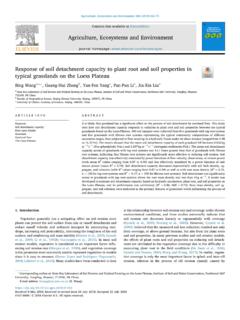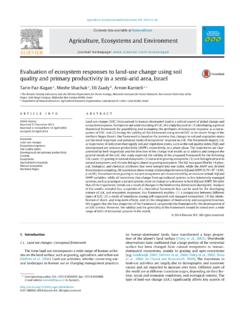Transcription of Agriculture, Ecosystems and Environment - California
1 agriculture , Ecosystems and Environment 154 (2012) 78 84. Contents lists available at ScienceDirect agriculture , Ecosystems and Environment journal homepage: Ecosystem service evaluation to support land-use policy Viglizzo a,b,c, , Paruelo d , P. Laterra e,f , Jobb gy g a INTA, EEA Anguil, Grupo de Investigaciones en Gesti n Ambiental (GIGA), Av. Spinetto 785, 6300 Santa Rosa, La Pampa, Argentina b INCITAP-CONICET, Ruta 35, km 335, 6300 Santa Rosa, La Pampa, Argentina c UNLPam, Facultad de Ciencias Exactas y Naturales, Av. Uruguay 151, 6300 Santa Rosa, La Pampa, Argentina d Laboratorio de An lisis Regional y Teledetecci n, Departamento de M todos Cuantitativos Sistemas de informaci n, Facultad de Agronom a and IFEVA, Universidad de Buenos Aires and CONICET, Avda. San Mart n, 4453 Buenos Aires, 1417, Argentina e Unidad Integrada Balcarce: EEA Balcarce, Instituto Nacional de Tecnolog a Agropecuaria, Facultad de Ciencias Agrarias, Universidad Nacional de Mar del Plata, CC 276, 7620 Balcarce, Argentina f CONICET, Andes 950, 5700, San Luis, San Luis, Argentina g Grupo de Estudios Ambientales IMASL, Ej rcito de los, Andes 950, 5700, San Luis, San Luis, Argentina a r t i c l e i n f o a b s t r a c t Article history: Regular economic activity takes into account ecosystem goods and services that are exchanged for money Received 2 March 2011 in the market ( food, bre, water) but normally ignores more intangible ones left away from market Received in revised form 13 July 2011 transactions ( soil protection, climate regulation, disturbance control, habitat provision), even in cases Accepted 15 July 2011.
2 When they become irreversibly impaired. However, because of the increasing pressure brought by the Available online 15 September 2011. public opinion, the attempts to assign an economic, yet volatile, valuation to Ecosystems assets has multiplied in recent years, and policy communities are increasingly compelled to incorporate them into Keywords: land use planning initiatives. Based on contributions to this special issue, we discuss how the perspective Evaluation methods Economic and biophysical views of ecosystem services can contribute to develop sound land-use policies and planning actions. Beyond Tradeoffs valuation, several practical implications emerge from the contributions. A myriad of potential tradeoffs must be analyzed because since the provision of some services can be accompanied by the emergence of unexpected dis-services. For example, carbon accumulation based on increasing net primary production rates may simultaneously cut water yields and, hence, water provision.
3 Various existing mechanisms ranging from state-controlled to market-controlled for rewarding the provision of ecosystem services are analyzed and discussed in terms of their capacity to connect nature to land-use planning. 2011 Elsevier All rights reserved. 1. Introduction involve essential processes that contribute to ecosystem service provision, and (iii) ecosystem processes comprise the transference Modern views on land-use policy aim at getting a long-lasting of energy ( , chemical energy), material ( , nutrients, water). harmonization of economic, social and environmental interests in and information ( , genes, cultural information) among func- the society at the regional to local levels. In the practice, however, tional compartments. In this context, despite the economic growth such attempt may be jeopardized by con icting interests among and social development are normally considered a priority in most sectors regarding land-use.
4 Societies often obtain economic bene- societies the increasing sensitivity of people regarding the provi- ts at the expense of ecological functions and processes such energy sion of goods and services by nature poses new challenges in policy ows, nutrient cycling and water processes (Ring, 2008) associated making (Eickhout et al., 2007). Since the mid-1980s, the greater with essential ecosystem service (ES) provisioning (Haygarth and public awareness about nature (Stoate et al., 2001; Robinson and Ritz, 2009). Because concepts are used many times in this article, in Sutherland, 2002) has led to recognize the need of regulations, line with MA (2005) a brief de nition of ecosystem services, func- nancial instruments and technologies to address the conservation tions and processes is necessary: (i) ecosystem services are the of ecosystem services (Burgess and Morris, 2009). bene ts that humans get from nature ( food, climate regula- The idea of ecosystem services (ES), generally de ned as the tion), (ii) ecosystem functions ( , energy ow, nutrient cycling) bene t that people obtain from Ecosystems (MA, 2005), has had an increasing presence in the discussion of environmental issues since its introduction thirty years ago (Mooney and Ehrlich, 1997).
5 The relative simplicity of the concept, its relationship with natu- Corresponding author at: INTA, EEA Anguil, Grupo de Investigaciones en Gesti n ral capital valuation (Daily et al., 2009), its direct association with Ambiental (GIGA), Av. Spinetto 785, 6300 Santa Rosa, La Pampa, Argentina. Tel.: +54 2954 434 222; fax: +54 2954 434 222. ecosystem functions (Costanza et al., 1997), the possibility of a bet- E-mail address: ( Viglizzo). ter understanding with economists and social scientists, and the 0167-8809/$ see front matter 2011 Elsevier All rights reserved. Viglizzo et al. / agriculture , Ecosystems and Environment 154 (2012) 78 84 79. expectation to make it operative to solve environmental con icts because the intrinsic non-value use of some natural assets, like and to assess the multiple consequences of land-use changes, have species diversity, is ignored. For example, setting aside the intrin- likely contributed to spread the ES concept.
6 The report of the Mil- sic value of the existence of species or their dif cult-to-estimate lennium Ecosystem Assessment (MA, 2005) clearly links the level value, conservation of redundant species is hardly justi ed taking of provision of ES to human welfare, stressing the anthropocentric into account their current contribution to essential services that are nature of the ES idea (Goulden and Kennedy, 1997). An appeal- of human interest. The economic valuation of the ES has been crit- ing characteristic of ES from a biophysical viewpoint is the direct icized as a mechanism for making decisions when information and link with structural and functional aspects of Ecosystems (Costanza data are the result of subjective estimations collected, for exam- et al., 1997). Fisher et al. (2009) makes this point explicit by de n- ple, among different consumer categories (Carpenter et al., 2009).
7 Ing ES as the aspects of Ecosystems utilized (actively or passively) In spite of this criticism, economic valuation remains as one of the to generate human well-being (see also Boyd and Banzhaf, 2007; most studied aspects of ES and the lack of a proper monetary valu- Boyd et al., 2001). ation is identi ed as an important driver of decreasing ES provision A growing concern in land-use policy is how to equally incorpo- (MA, 2005). rate economic, social indicators and ecosystem-service valuations Despite the effort applied to develop practical and effective in a well-balanced decision-making matrix (Kremen et al., 2005). methods of ES valuation for policy making, successful examples Both economic and social indicators usually offer simple measure- are relatively rare (Ruffo and Kareiva, 2009). Most of them looked ments that are understandable and manageable by the general at services associated with water provisioning, as it happens with public (Daily, 1997).
8 In contrast, the valuation of ecosystem ser- the well-known case of Catskills Basin in the state of New York vices still shows several restrictions in approach and methods that (Chichilnisky and Heal, 1998). hinder adoption and explain the large disparity between initiatives Besides the problem of pricing ES when no markets exist, a crit- to incorporate the value of ecosystem service into land-use poli- ical limitation is the dif culty to establish quantitatively to what cies (Wunder et al., 2008). Such differences may re ect, among extent changes in land use, and the associated shifts they impose other things, socio-economic and cultural gaps among communi- on ecosystem functions, will modify the level of provision of a given ties, underestimation of nature as provider of ecosystem services, ES ( , production functions of ES). Production functions have been and disagreement about valuation methods (Kosoy et al.)
9 , 2007; characterized for goods and services with market value in culti- Engel et al., 2008). vated and forest Ecosystems (Daily et al., 2009), including the links This article aims at providing: (i) an overview about the con- between primary productivity and meat production or those that ict between economic and biophysical evaluation of ES, (ii) a assess the level of soil protection and quality and forest yields. background discussion on the evaluation of ES and the way it can However, for most ES they are not clearly identi ed and quanti- underpin land-use policy and (iii) a brief discussion on how the ed. Another problem associated with economic valuation of ES is results of the articles within this special issue contribute to assess that it assumes marginal changes (small changes in the amount of and integrate ES into land use policy. Most of the articles of this an ES affects its monetary value), which are dif cult to de ne for special issue highlight the importance of the biophysical evalu- most ecosystem processes (Heal, 2000).
10 As Carreno et al. (2012). ation of ES provision and their response to land use changes. In emphasized, the economic methods for pricing single services in the following sections we discussed the shortcomings of monetary monetary terms are markedly subjective and may say nothing if approaches to value ES and the potentials of the biophysical evalu- money cannot be related to ecosystem functions that are associated ation to incorporate the concept into decision making and land use with service provision. They conclude, as some authors did before planning process. (Odum, 1988, 1996; Costanza et al., 1998; Odum and Odum, 2000), that the use of biophysical approaches and methods is necessary to get objective and comparable valuations. 2. Ecosystem service valuation: beyond economics An important issue of assigning monetary values to ecosystem services has to do with the ideological choice, not always explicitly Humanity has a long history of managing provisioning services assumed, that is made when the ES analysis is enrolled into a mar- (food, bre, energy, water, raw materials) as commodities that are ket rationale.









